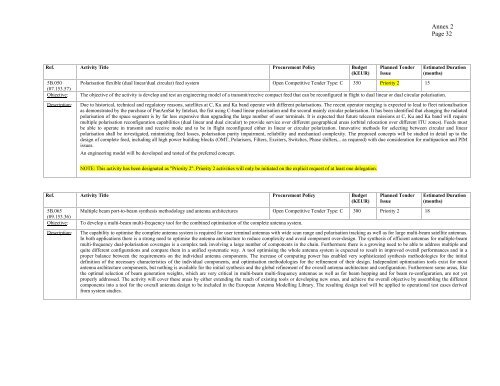ARTES-5.1 â ESA Telecom Technology Workplan ... - Emits - ESA
ARTES-5.1 â ESA Telecom Technology Workplan ... - Emits - ESA
ARTES-5.1 â ESA Telecom Technology Workplan ... - Emits - ESA
- No tags were found...
Create successful ePaper yourself
Turn your PDF publications into a flip-book with our unique Google optimized e-Paper software.
Annex 2Page 32Ref. Activity Title Procurement Policy Budget(KEUR)5B.050(07.153.57)Objective:Description:Planned TenderIssuePolarisation flexible (dual linear/dual circular) feed system Open Competitive Tender Type: C 350 Priority 2 15Estimated Duration(months)The objective of the activity is develop and test an engineering model of a transmit/receive compact feed that can be reconfigured in flight to dual linear or dual circular polarisation.Due to historical, technical and regulatory reasons, satellites at C, Ku and Ka band operate with different polarisations. The recent operator merging is expected to lead to fleet rationalisationas demonstrated by the purchase of PanAmSat by Intelsat, the fist using C-band linear polarisation and the second mainly circular polarisation. It has been identified that changing the radiatedpolarisation of the space segment is by far less expensive than upgrading the large number of user terminals. It is expected that future telecom missions at C, Ku and Ka band will requiremultiple polarisation reconfiguration capabilities (dual linear and dual circular) to provide service over different geographical areas (orbital relocation over different ITU zones). Feeds mustbe able to operate in transmit and receive mode and to be in flight reconfigured either in linear or circular polarization. Innovative methods for selecting between circular and linearpolarisation shall be investigated, minimizing feed losses, polarisation purity impairment, reliability and mechanical complexity. The proposed concepts will be studied in detail up to thedesign of complete feed, including all high power building blocks (OMT, Polarisers, Filters, Exciters, Switches, Phase shifters,.. as required) with due consideration for multipaction and PIMissues.An engineering model will be developed and tested of the preferred concept.NOTE: This activity has been designated as "Priority 2". Priority 2 activities will only be initiated on the explicit request of at least one delegation.Ref. Activity Title Procurement Policy Budget(KEUR)5B.065(09.153.36)Objective:Description:Planned TenderIssueMultiple beam port-to-beam synthesis methodology and antenna architectures Open Competitive Tender Type: C 300 Priority 2 18To develop a multi-beam multi-frequency tool for the combined optimisation of the complete antenna system.Estimated Duration(months)The capability to optimise the complete antenna system is required for user terminal antennas with wide scan range and polarisation tracking as well as for large multi-beam satellite antennas.In both applications there is a strong need to optimise the antenna architecture to reduce complexity and avoid component over-design. The synthesis of efficient antennas for multiple-beammulti-frequency dual-polarisation coverages is a complex task involving a large number of components in the chain. Furthermore there is a growing need to be able to address multiple andquite different configurations and compare them in a unified systematic way. A tool optimising the whole antenna system is expected to result in improved overall performances and in aproper balance between the requirements on the individual antenna components. The increase of computing power has enabled very sophisticated synthesis methodologies for the initialdefinition of the necessary characteristics of the individual components, and optimisation methodologies for the refinement of their design. Independent optimisation tools exist for mostantenna architecture components, but nothing is available for the initial synthesis and the global refinement of the overall antenna architecture and configuration. Furthermore some areas, likethe optimal selection of beam generation weights, which are very critical in multi-beam multi-frequency antennas as well as for beam hopping and for beam re-configuration, are not yetproperly addressed. The activity will cover these areas by either extending the reach of existing tools or developing new ones, and achieve the overall objective by assembling the differentcomponents into a tool for the overall antenna design to be included in the European Antenna Modelling Library. The resulting design tool will be applied to operational test cases derivedfrom system studies.
















